TDS Similarity: Outlier Analysis Using a Similarity Index to Compare Time-Series Responses of Temporal Dominance of Sensations Tasks
Abstract
1. Introduction
2. TDS Method and Task
3. Similarity Index for TDS Trials
4. TDS Data of Strawberries
5. Similarity Index with Different R Values: Example of Strawberries
6. Outlier Detection
6.1. Methods
6.2. Example of Strawberries
6.3. Discussion: Semantic Validity of Outliers
7. General Discussion
8. Conclusions
Author Contributions
Funding
Data Availability Statement
Conflicts of Interest
References
- ISO 13299; Sensory Analysis–Methodology–General Guidance for Establishing a Sensory Profile. International Organization for Standarzation: Geneva, Switzerland, 2016.
- Pineau, N.; Schlich, P.; Cordelle, S.; Mathonniére, C.; Issanchou, S.; Imbert, A.; Rogeaux, M.; Etiévant, P.; Köster, E. Temporal dominance of sensations: Construction of the TDS curves and comparison with time-intensity. Food Qual. Prefer. 2009, 20, 450–455. [Google Scholar] [CrossRef]
- Running, C.A. Oral sensations and secretions. Physiol. Behav. 2018, 193, 234–237. [Google Scholar] [CrossRef] [PubMed]
- Green, B.G.; Nachtigal, D. Somatosensory factors in taste perception: Effects of active tasting and solution temperature. Physiol. Behav. 2012, 107, 488–495. [Google Scholar] [CrossRef] [PubMed]
- Pellegrino, R.; Sinding, C.; de Wijk, R.; Hummel, T. Habituation and adaptation to odors in humans. Physiol. Behav. 2017, 177, 13–19. [Google Scholar] [CrossRef] [PubMed]
- Thomas-Danguin, T.; Guichard, E.; Salles, C. Cross-modal interactions as a strategy to enhance salty taste and to maintain liking of low-salt food: A review. Food Funct. 2019, 10, 5269–5281. [Google Scholar] [CrossRef] [PubMed]
- Wang, G.; Bakke, A.J.; Hayes, J.E.; Hopfer, H. Demonstrating cross-modal enhancement in a real food with a modified ABX test. Food Qual. Prefer. 2019, 77, 206–213. [Google Scholar] [CrossRef]
- Greis, M.; Kukkonen, R.; Lampi, A.M.; Seppä, L.; Partanen, R.; Sandell, M. The Impact of Vanilla and Lemon Aromas on Sensory Perception in Plant-Based Yogurts Measured with Static and Dynamic Methods. Foods 2022, 11, 2030. [Google Scholar] [CrossRef]
- Kakutani, Y.; Narumi, T.; Kobayakawa, T.; Kawai, T.; Kusakabe, Y.; Kunieda, S.; Wada, Y. Taste of breath: The temporal order of taste and smell synchronized with breathing as a determinant for taste and olfactory integration. Sci. Rep. 2017, 7, 8922. [Google Scholar] [CrossRef]
- Kim, K.; Bae, J.; Jin, Y.; Moon, C. Odor habituation can modulate very early olfactory event-related potential. Sci. Rep. 2020, 10, 18117. [Google Scholar] [CrossRef]
- Lee, W.; Pangborn, M.W. Time-intensity: The temporal aspects of sensory perception. Food Technol. 1986, 40, 71–78. [Google Scholar]
- Duizer, L.; Gullett, E.; Findlay, C. Time-intensity methodology for beef tenderness perception. J. Food Sci. 1993, 58, 943–947. [Google Scholar] [CrossRef]
- Pineau, N.; Schilch, P. 13—Temporal dominance of sensations (TDS) as a sensory profiling technique. In Rapid Sensory Profiling Techniques; Delarue, J., Lawlor, J.B., Rogeaux, M., Eds.; Woodhead Publishing Series in Food Science, Technology and Nutrition; Woodhead Publishing: Sawston, UK, 2015; pp. 269–306. [Google Scholar] [CrossRef]
- Di Monaco, R.; Su, C.; Masi, P.; Cavella, S. Temporal dominance of sensations: A review. Trends Food Sci. Technol. 2014, 38, 104–112. [Google Scholar] [CrossRef]
- Schlich, P. Temporal dominance of sensations (TDS): A new deal for temporal sensory analysis. Curr. Opin. Food Sci. 2017, 15, 38–42. [Google Scholar] [CrossRef]
- Kantono, K.; Hamid, N.; Shepherd, D.; Lin, Y.H.T.; Skiredj, S.; Carr, B.T. Emotional and electrophysiological measures correlate to flavour perception in the presence of music. Physiol. Behav. 2019, 199, 154–164. [Google Scholar] [CrossRef] [PubMed]
- Merlo, T.C.; Soletti, I.; Saldaña, E.; Menegali, B.S.; Martins, M.M.; Teixeira, A.C.B.; dos Santos Harada-Padermo, S.; Dargelio, M.D.; Contreras-Castillo, C.J. Measuring dynamics of emotions evoked by the packaging colour of hamburgers11The word hamburger is defined as a sandwich consisting of a cooked patty of ground or chopped beef, usually in a roll or bun, variously garnished. using Temporal Dominance of Emotions (TDE). Food Res. Int. 2019, 124, 147–155. [Google Scholar] [CrossRef] [PubMed]
- Peltier, C.; Visalli, M.; Thomas, A. Using temporal dominance of emotions at home. Impact of coffee advertisements on consumers’ behavior and methodological perspectives. Food Qual. Prefer. 2019, 71, 311–319. [Google Scholar] [CrossRef]
- Boinbaser, L.; Parente, M.E.; Castura, J.C.; Ares, G. Dynamic sensory characterization of cosmetic creams during application using Temporal Check-All-That-Apply (TCATA) questions. Food Qual. Prefer. 2015, 45, 33–40. [Google Scholar] [CrossRef]
- Nagano, H.; Saito, N.; Matsumori, K.; Kazama, T.; Konyo, M.; Yokokohji, Y. On the Analysis of Tactile Sensation Based on Time Measurement: An Experimental Case Study on the Interaction Between Skin and Lotion. IEEE Trans. Haptics 2023, 16, 1–6. [Google Scholar] [CrossRef]
- Castura, J.C.; Antúnez, L.; Giménez, A.; Ares, G. Temporal Check-All-That-Apply (TCATA): A novel dynamic method for characterizing products. Food Qual. Prefer. 2016, 47, 79–90. [Google Scholar] [CrossRef]
- Castura, J.; Rutledge, D.; Ross, C.; Næs, T. Discriminability and uncertainty in principal component analysis (PCA) of temporal check-all-that-apply (TCATA) data. Food Qual. Prefer. 2022, 96, 104370. [Google Scholar] [CrossRef]
- Thomas, A.; Visalli, M.; Cordelle, S.; Schlich, P. Temporal Drivers of Liking. Food Qual. Prefer. 2015, 40, 365–375. [Google Scholar] [CrossRef]
- Greis, M.; Sainio, T.; Katina, K.; Kinchla, A.J.; Nolden, A.; Partanen, R.; Seppä, L. Dynamic texture perception in plant-based yogurt alternatives: Identifying temporal drivers of liking by TDS. Food Qual. Prefer. 2020, 86, 104019. [Google Scholar] [CrossRef]
- Lenfant, F.; Loret, C.; Pineau, N.; Hartmann, C.; Martin, N. Perception of oral food breakdown. The concept of sensory trajectory. Appetite 2009, 52, 659–667. [Google Scholar] [CrossRef]
- Okada, T.; Okamoto, S.; Yamada, Y. Affective dynamics: Causality modeling of temporally evolving perceptual and affective responses. IEEE Trans. Affect. Comput. 2022, 13, 628–639. [Google Scholar] [CrossRef]
- Okamoto, S. Structural modeling of temporal dominance responses using covariances of contemporary changes in subjective qualities. Int. J. Affect. Eng. 2021, 20, 127–130. [Google Scholar] [CrossRef]
- Meyners, M. Panel and panelist agreement for product comparisons in studies of temporal dominance of sensations. Food Qual. Prefer. 2011, 22, 365–370. [Google Scholar] [CrossRef]
- Lepage, M.; Neville, T.; Rytz, A.; Schlich, P.; Martin, N.; Pineau, N. Panel performance for temporal dominance of sensations. Food Qual. Prefer. 2014, 38, 24–29. [Google Scholar] [CrossRef]
- Cardot, H.; Lecuelle, G.; Schlich, P.; Visalli, M. Estimating finite mixtures of semi-Markov chains: An application to the segmentation of temporal sensory data. J. R. Stat. Soc. Ser. C R. Stat. Soc. 2019, 68, 1281–1303. [Google Scholar] [CrossRef]
- Lecuelle, G.; Visalli, M.; Cardot, H.; Schlich, P. Modeling temporal dominance of sensations with semi-Markov chains. Food Qual. Prefer. 2018, 67, 59–66. [Google Scholar] [CrossRef]
- Okamoto, S. Bootstrap resampling of temporal dominance of sensations curves to compute uncertainties. Foods 2021, 10, 2472. [Google Scholar] [CrossRef]
- Puputti, S.; Aisala, H.; Hoppu, U.; Sandell, M. Multidimensional measurement of individual differences in taste perception. Food Qual. Prefer. 2018, 65, 10–17. [Google Scholar] [CrossRef]
- Roukka, S.; Puputti, S.; Aisala, H.; Hoppu, U.; Seppä, L.; Sandell, M.A. The individual differences in the perception of oral chemesthesis are linked to taste sensitivity. Foods 2021, 10, 2730. [Google Scholar] [CrossRef] [PubMed]
- Norton, V.; Lignou, S.; Methven, L. Influence of age and individual differences on mouthfeel perception of whey protein-fortified products: A review. Foods 2021, 10, 433. [Google Scholar] [CrossRef]
- Hyldelund, N.B.; Frederiksen, C.; Byrne, D.V.; Andersen, B.V. Is stress taking the pleasure out of food?—A characterization of the food pleasure profiles, appetite, and eating behaviors of people with chronic stress. Foods 2022, 11, 1980. [Google Scholar] [CrossRef]
- Lin, Y.H.T.; Hamid, N.; Shepherd, D.; Kantono, K.; Spence, C. Musical and non-musical sounds influence the flavour perception of chocolate ice cream and emotional responses. Foods 2022, 11, 1784. [Google Scholar] [CrossRef] [PubMed]
- Shimaoka, N.; Okamoto, S.; Akiyama, Y.; Yamada, Y. Linking temporal dominance of sensations for primary-sensory and multi-sensory attributes using canonical correlation analysis. Foods 2022, 11, 781. [Google Scholar] [CrossRef]
- Natsume, H.; Okamoto, S.; Shimaoka, N. Outlier analysis in time-evolving sensory evaluation tasks. In Proceedings of the Global Conference on Life Sciences and Technologies, Osaka, Japan, 7–9 March 2022; pp. 212–213. [Google Scholar] [CrossRef]
- Rousseeuw, P.J.; Leroy, A.M. Robust Regression and Outlier Detection; Wiley Series in Probability and Statistics; John Wiley & Sons, Inc.: Hoboken, NJ, USA, 1987. [Google Scholar] [CrossRef]
- Meyners, M. Temporal liking and CATA analysis of TDS data on flavored fresh cheese. Food Qual. Prefer. 2016, 47, 101–108. [Google Scholar] [CrossRef]
- Natsume, H.; Okamoto, S.; Nagano, H. Hierarchical clustering analysis of the temporal dominance of sensations tasks. In Proceedings of the International Symposium on Affective Science and Engineering, Online, 8 March 2023; p. C00012. [Google Scholar]
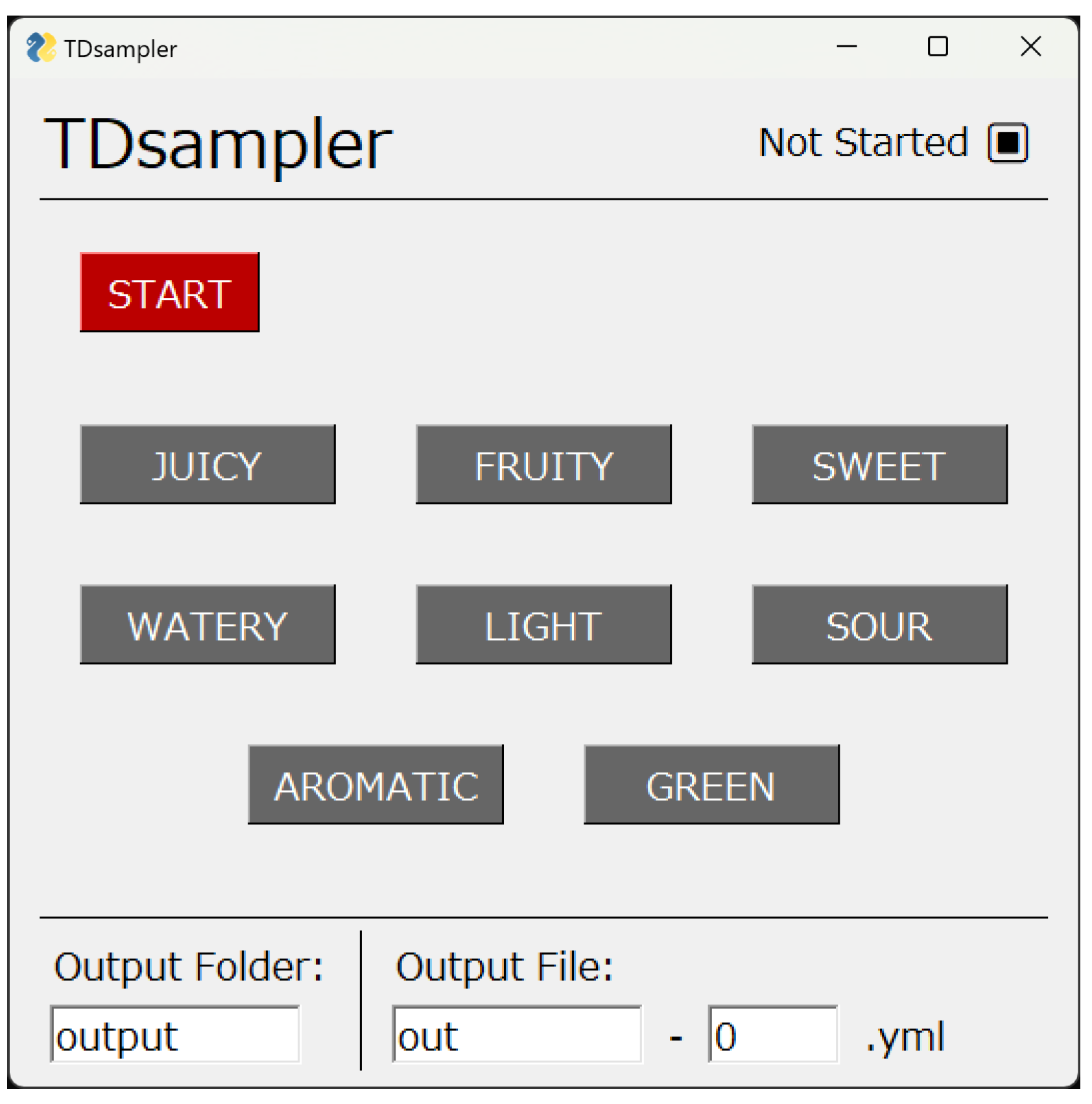
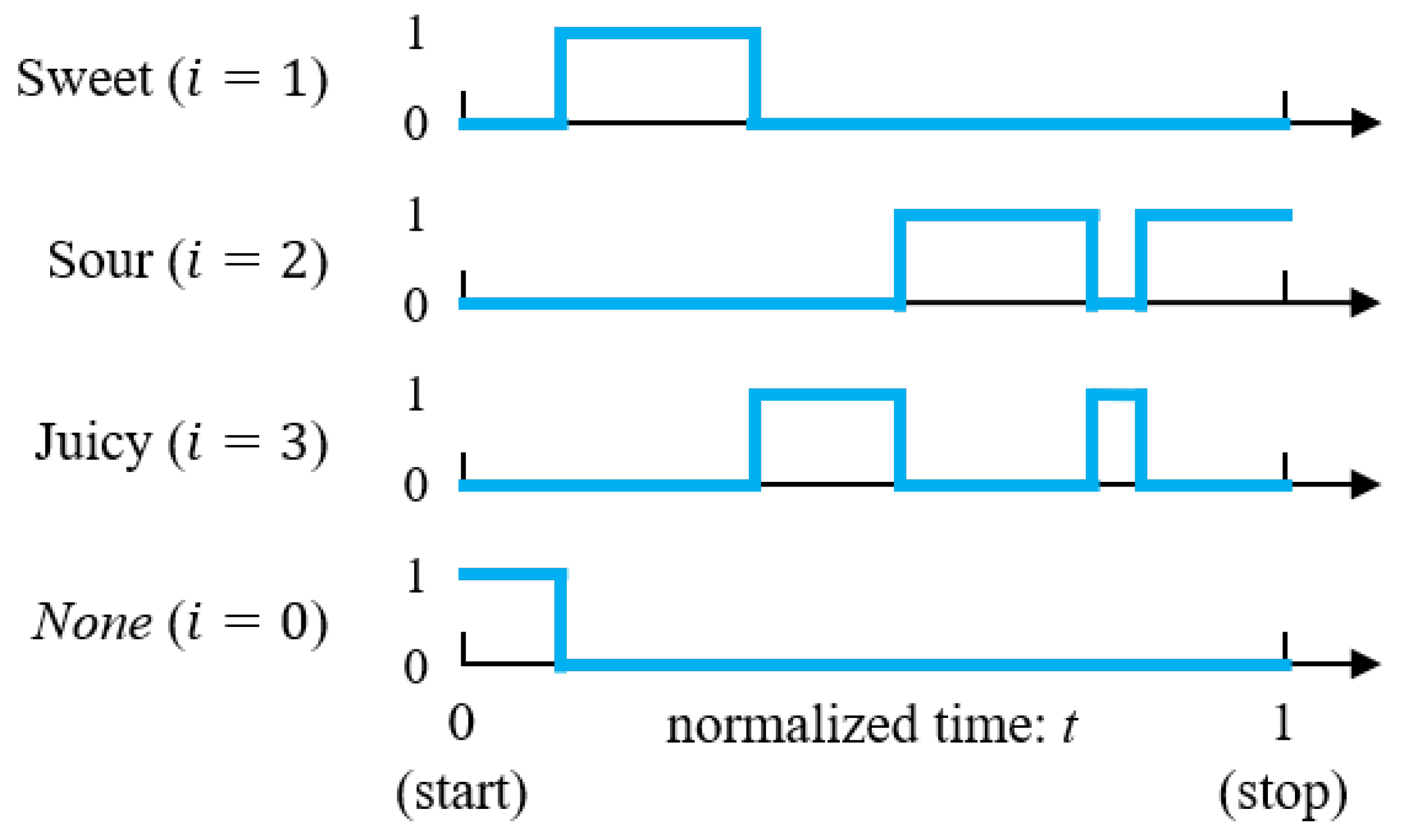
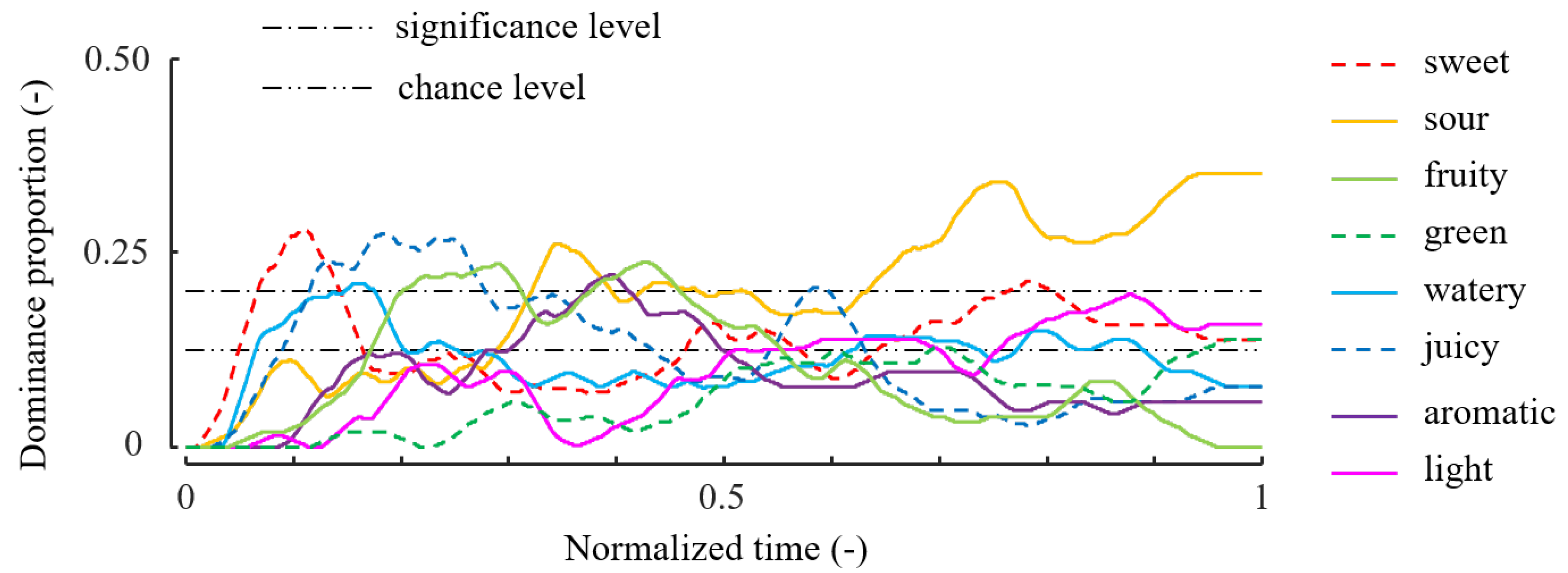
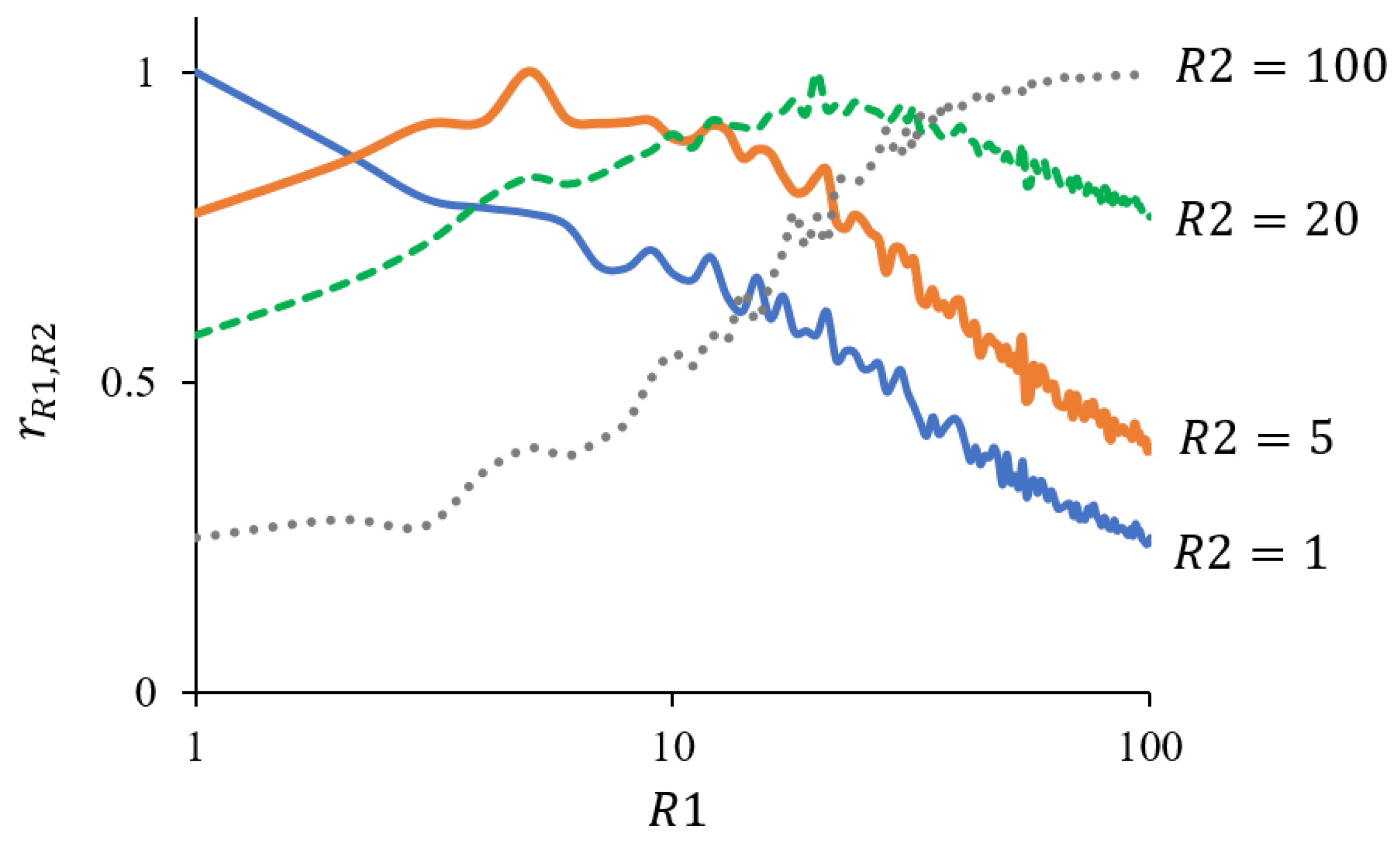
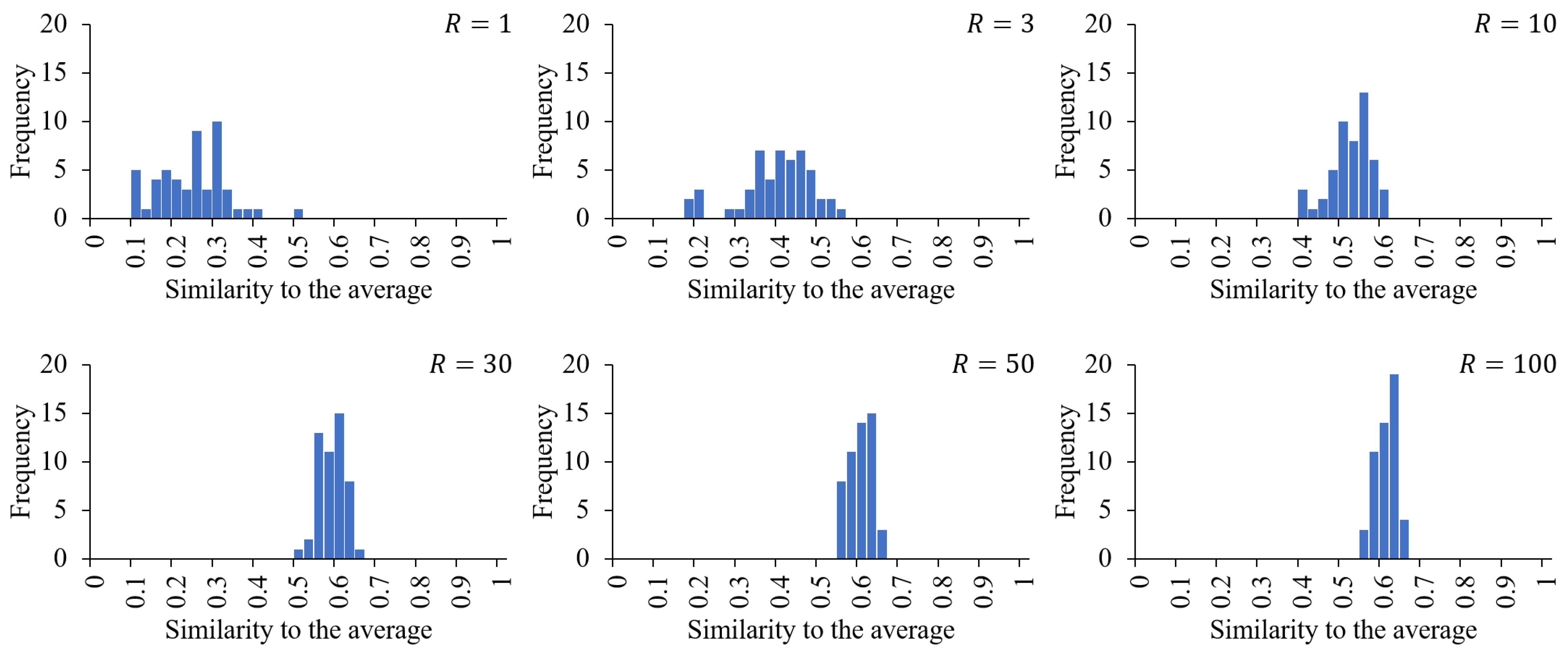
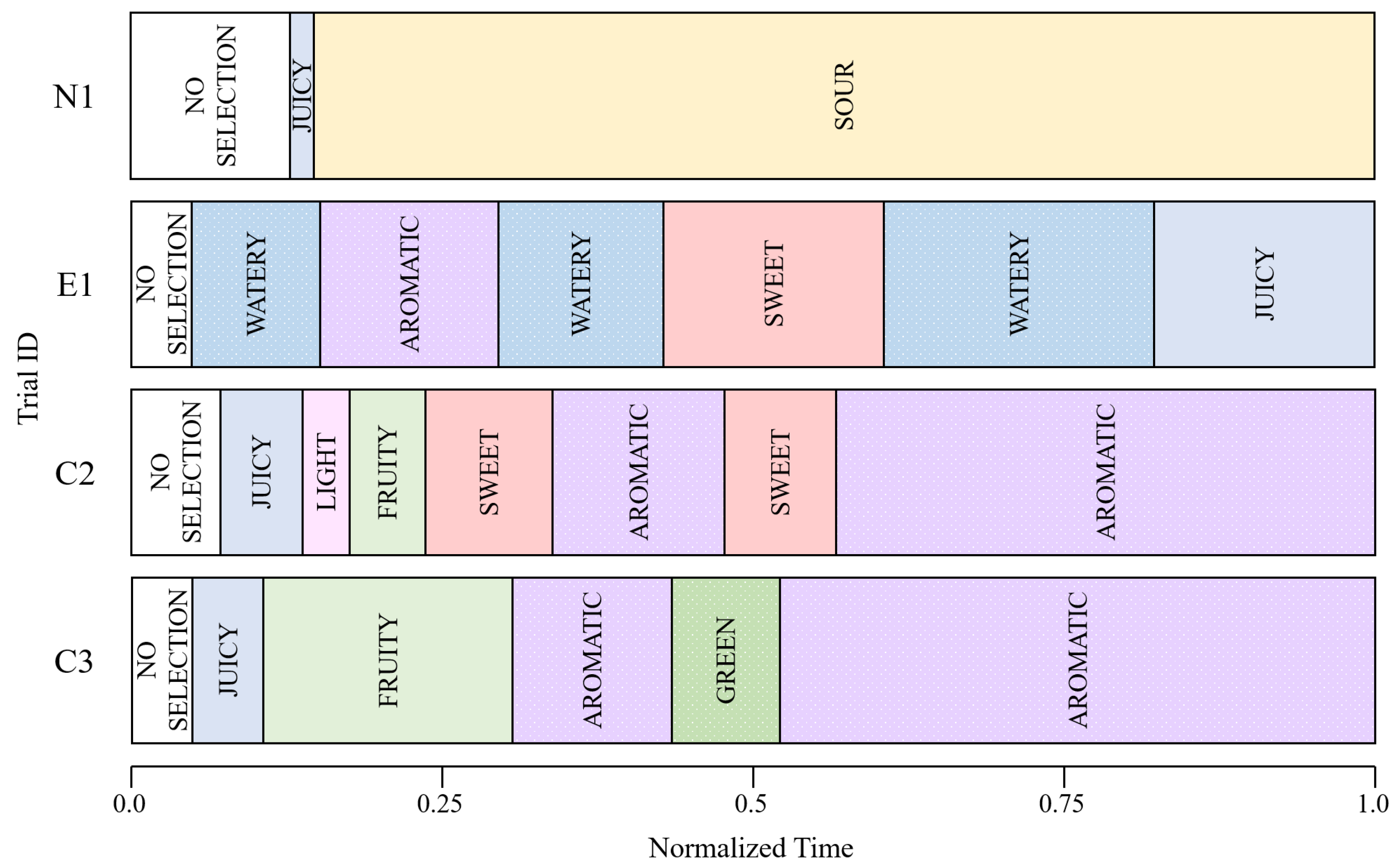
| 1 | 3 | 10 | 30 | 50 | 100 | ||
|---|---|---|---|---|---|---|---|
| 1 | 1.000 | ||||||
| 3 | 0.797 | 1.000 | |||||
| 10 | 0.675 | 0.826 | 1.000 | ||||
| 30 | 0.521 | 0.594 | 0.848 | 1.000 | |||
| 50 | 0.385 | 0.429 | 0.693 | 0.941 | 1.000 | ||
| 100 | 0.251 | 0.269 | 0.548 | 0.865 | 0.972 | 1.000 | |
| R | |||||||
|---|---|---|---|---|---|---|---|
| 1 | 3 | 10 | 30 | 50 | 100 | ||
| Trial ID | N1 | + | |||||
| E1 | + | + | |||||
| C2 | + | ||||||
| C3 | + | + | + | + | + | + | |
Disclaimer/Publisher’s Note: The statements, opinions and data contained in all publications are solely those of the individual author(s) and contributor(s) and not of MDPI and/or the editor(s). MDPI and/or the editor(s) disclaim responsibility for any injury to people or property resulting from any ideas, methods, instructions or products referred to in the content. |
© 2023 by the authors. Licensee MDPI, Basel, Switzerland. This article is an open access article distributed under the terms and conditions of the Creative Commons Attribution (CC BY) license (https://creativecommons.org/licenses/by/4.0/).
Share and Cite
Natsume, H.; Okamoto, S.; Nagano, H. TDS Similarity: Outlier Analysis Using a Similarity Index to Compare Time-Series Responses of Temporal Dominance of Sensations Tasks. Foods 2023, 12, 2025. https://doi.org/10.3390/foods12102025
Natsume H, Okamoto S, Nagano H. TDS Similarity: Outlier Analysis Using a Similarity Index to Compare Time-Series Responses of Temporal Dominance of Sensations Tasks. Foods. 2023; 12(10):2025. https://doi.org/10.3390/foods12102025
Chicago/Turabian StyleNatsume, Hiroharu, Shogo Okamoto, and Hikaru Nagano. 2023. "TDS Similarity: Outlier Analysis Using a Similarity Index to Compare Time-Series Responses of Temporal Dominance of Sensations Tasks" Foods 12, no. 10: 2025. https://doi.org/10.3390/foods12102025
APA StyleNatsume, H., Okamoto, S., & Nagano, H. (2023). TDS Similarity: Outlier Analysis Using a Similarity Index to Compare Time-Series Responses of Temporal Dominance of Sensations Tasks. Foods, 12(10), 2025. https://doi.org/10.3390/foods12102025






